Multi-Scenario Simulation of Land Use Change Along with Ecosystem Service Value for the Lanzhou–Xining Urban Agglomeration
Abstract
1. Introduction
2. Data and Methods
2.1. Research Area and Data Sources
2.1.1. Research Area
2.1.2. Data Sources and Handling
2.2. Research Methods
2.2.1. Land Use Transfer Matrix
2.2.2. ESV Estimation
Principles and Operation of the Equivalent Factor Method
Improvement and Calibration of the Equivalent Factor Method
2.2.3. PLUS Model
PLUS Model Drivers of Land Use
Neighborhood Weight
Multi-Scenario Settings
- (1)
- The NDS, according to the characteristics of land use transfer in the historical context, applies the Markov chain demand forecasting module in the PLUS model to access the area of each land use type based on the change rule of land use between 2010 and 2020. In this scenario, the transfer of CSL to other land use types is restricted, and the remaining land use types can be transferred to each other.
- (2)
- The CLPS was developed according to the LXUA Development Plan’s increased requirements for the protection of CL, which restricts the occupation of CL by other land use types so the amount of CL can be well ensured. In this scenario, the transfer of CL to other land use types is restricted, and the transfer of FL, GL, and UL to CL is allowed.
- (3)
- The ECS was developed according to the requirement to increase the protection of ecological land in the Yellow River Basin Ecological Conservation and High-Quality Development Plan, in which context the nature reserves and WA within the LXUA are regarded as restricted conversion areas. This scenario restricts the transfer of FL, GL, and WA to CSL, and allows the transfer of UL and CL to FL, GL, and WA.
3. Results Analysis
3.1. Features of LUC
3.2. Characteristics of Change in ESV
3.3. Evolutionary Trends in Land Use and ESV Under Different Scenarios
3.3.1. Evolutionary Trends of LUC
3.3.2. Evolutionary Trends of ESV
4. Discussion
4.1. Similarities and Differences Between This Research and Previous Research
4.1.1. Breakthroughs in Research Perspectives
4.1.2. Exploration of Empirical Research
4.2. Policy Implications
4.2.1. Controlling Cut Mountains and Creating Land in the Expansion of Central Cities
4.2.2. Promoting the Return of CL to GL and Ecological Restoration in Peripheral Villages
4.2.3. Valuing GL as a Major Player in the ESV
4.2.4. Harnessing the Speeding-Up Function of WA in the ESV
4.3. Limitation
4.3.1. Driving Mechanism of ESV
4.3.2. Carbon Fixation and Storage
4.3.3. ESV of Wetland
4.3.4. Negative Impacts of Construction Land on the ESV
4.4. Future Research
4.4.1. U-Curve Theory of Regional Development Levels and the ESV
4.4.2. The Extent to Which the Level of Regional Development Affects the ESV
4.4.3. Spatial Effects of Regional Development Levels on the ESV
5. Conclusions
- (1)
- The land use type of the LXUA from 2000 to 2020 was dominated by GL, accounting for more than 60% of the gross area. The shift of CL and GL was the most significant, but the shift of GL to CL was greater. As urbanization continues to accelerate, the sprawl of CSL encroaches on both GL and CL.
- (2)
- The ESV of the LXUA between 2000 and 2020 increased year by year, with a cumulative increase of 57.04 × 108 yuan and a growth rate of 2.67%, mainly due to the faster increase in the area of WA, which made the ESVs of WA continue to rise and had the largest increment, with a cumulative increase of 50.97 × 108 yuan and a growth rate of 12.45%. In 2000–2020, GL contributed the most to the ESVs, accounting for 53.44% to 52.56%, and HJ and CR contributed the most to the ESV of individuals, with a combined share of 50.86% to 51.69%.
- (3)
- Through the scenario simulation of the spatial and temporal pattern of land use in the LXUA in 2030, under the NDS, the area of CSL increases by 646.62 km2, with a growth rate of 27.67%, occupying a lot of GL and CL, and the sprawl of urban areads is not constrained. Under the CLPS, the area of CL increases significantly by 342.64 km2, with a growth rate of 1.85%. The area of CSL increases by 218.67 km2, with a growth rate of 9.36% compared with the NDS. The sprawl of CSL was constrained in some measure. Under the ECS, the area of CSL increases by 270.95 km2, with a growth rate of 11.60%. The increase in CSL was mainly in the way of the transfer of CL, the encroachment on ecological land was controlled, and there was an increase in the areas of FL, GL, and WA.
- (4)
- The ESVs of the LXUA under the NDS, the CLPS, and the ECS are 2183.89 × 108 yuan, 2148.46 × 108 yuan, and 2211.06 × 108 yuan in 2030, respectively. Compared with 2020, the ESV decreases under the ND and CLPS, at 7.58 × 108 yuan and 43.02 × 108 yuan, respectively. Under the NDS, the ESV of GL decreased by 6.54 × 108 yuan, accounting for 86.55% of the gross loss. Under the CLPS, the ESV of CL increased, but the ESV of WA decreased dramatically, resulting in a 1.96% decrease in the ESV, the lowest among the three scenarios. Under the ECS, ecological land was protected accordingly, increasing the ESV of FL, GL, and WA, with the ESV increasing by 0.89%, the highest among the three scenarios.
Author Contributions
Funding
Data Availability Statement
Conflicts of Interest
Abbreviations
| LUC | Land use change |
| ES | Ecosystem services |
| ESV | Ecosystem service value |
| ESVs | Ecosystem service values |
| LXUA | Lanzhou–Xining Urban Agglomeration |
| NDS | Natural development scenario |
| CLPS | Cultivated land protection scenario |
| ECS | Ecological conservation scenario |
| CSL | Construction land |
| CL | Cultivated land |
| FL | Forestland |
| GL | Grassland |
| WA | Water area |
| UL | Unused land |
| FP | Food production |
| RMP | Raw material production |
| WRS | Water resources supply |
| GR | Gas regulation |
| CR | Climate regulation |
| EP | Environment purification |
| HR | Hydrological regulation |
| SM | Soil maintenance |
| MNC | Maintaining nutrient circulation |
| BD | Biological diversity |
| AL | Aesthetic landscape |
References
- Hasan, S.S.; Zhen, L.; Miah, M.G.; Ahamed, T.; Samie, A. Impact of land use change on ecosystem services: A review. Environ. Dev. 2020, 34, 100527. [Google Scholar] [CrossRef]
- Wu, K.; Wang, D.; Lu, H.; Liu, G. Temporal and spatial heterogeneity of land use, urbanization, and ecosystem service value in China: A national-scale analysis. J. Clean. Prod. 2023, 418, 137911. [Google Scholar] [CrossRef]
- Costanza, R.; de Groot, R.; Braat, L.; Kubiszewski, I.; Fioramonti, L.; Sutton, P.; Farber, S.; Grasso, M. Twenty years of ecosystem services: How far have we come and how far do we still need to go? Ecosyst. Serv. 2017, 28, 1–16. [Google Scholar] [CrossRef]
- Duan, X.; Chen, Y.; Wang, L.; Zheng, G.; Liang, T. The impact of land use and land cover changes on the landscape pattern and ecosystem service value in Sanjiangyuan region of the Qinghai-Tibet Plateau. J. Environ. Manag. 2023, 325, 116539. [Google Scholar] [CrossRef]
- Gao, P.; Li, Y.; Gong, J.; Huang, G. Urban land-use planning under multi-uncertainty and multiobjective considering ecosystem service value and economic benefit—A case study of Guangzhou, China. Ecol. Complex. 2021, 45, 100886. [Google Scholar] [CrossRef]
- Li, S. Reflections on Ecosystem Service Research. Landsc. Arch. Front. 2019, 7, 82–87. [Google Scholar] [CrossRef]
- Liu, Z.; Wang, S.; Fang, C. Spatiotemporal evolution and influencing mechanism of ecosystem service value in the Guangdong-Hong Kong-Macao Greater Bay Area. J. Geogr. Sci. 2023, 33, 1226–1244. [Google Scholar] [CrossRef]
- Costanza, R.; d’Arge, R.; de Groot, R.; Farber, S.; Grasso, M.; Hannon, B.; Limburg, K.; Naeem, S.; O’Neill, R.V.; Paruelo, J.; et al. The value of the world’s ecosystem services and natural capital. Nature 1997, 387, 253–260. [Google Scholar] [CrossRef]
- Xie, G.; Zhang, C.; Zhen, L.; Zhang, L. Dynamic changes in the value of China’s ecosystem services. Ecosyst. Serv. 2017, 26, 146–154. [Google Scholar] [CrossRef]
- Wang, M.; Sun, X. Potential impact of land use change on ecosystem services in China. Environ. Monit. Assess. 2016, 188, 248. [Google Scholar] [CrossRef]
- Liu, F.; Yang, L.; Wang, S. Spatial and Temporal Evolution and Correlation Analysis of Landscape Ecological Risks and Ecosystem Service Values in the Jinsha River Basin. J. Resour. Ecol. 2023, 14, 914–927. [Google Scholar] [CrossRef]
- Li, R.; Xu, Q.; Yu, J.; Chen, L.; Peng, Y. Multiscale assessment of the spatiotemporal coupling relationship between urbanization and ecosystem service value along an urban–rural gradient: A case study of the Yangtze River Delta urban agglomeration, China. Ecol. Indic. 2024, 160, 111864. [Google Scholar] [CrossRef]
- Liu, J.; Pei, X.; Liao, B.; Zhang, H.; Liu, W.; Jiao, J. Scale effects and spatial heterogeneity of driving factors in ecosystem services value interactions within the Tibet autonomous region. J. Environ. Manag. 2024, 351, 119871. [Google Scholar] [CrossRef]
- Long, H.; Liu, Y.; Hou, X.; Li, T.; Li, Y. Effects of land use transitions due to rapid urbanization on ecosystem services: Implications for urban planning in the new developing area of China. Habitat Int. 2014, 44, 536–544. [Google Scholar] [CrossRef]
- Shifaw, E.; Sha, J.; Li, X.; Bao, Z.; Zhou, Z. An insight into land-cover changes and their impacts on ecosystem services before and after the implementation of a comprehensive experimental zone plan in Pingtan island, China. Land Use Policy 2019, 82, 631–642. [Google Scholar] [CrossRef]
- Song, W.; Deng, X.; Yuan, Y.; Wang, Z.; Li, Z. Impacts of land-use change on valued ecosystem service in rapidly urbanized North China Plain. Ecol. Model. 2015, 318, 245–253. [Google Scholar] [CrossRef]
- Rahaman, Z.A.; Kafy, A.A.; Faisal, A.-A.; Al Rakib, A.; Jahir, D.M.A.; Fattah, M.A.; Kalaivani, S.; Rathi, R.; Mallik, S.; Rahman, M.T. Predicting Microscale Land Use/Land Cover Changes Using Cellular Automata Algorithm on the Northwest Coast of Peninsular Malaysia. Earth Syst. Environ. 2022, 6, 817–835. [Google Scholar] [CrossRef]
- Verburg, P.H.; Soepboer, W.; Veldkamp, A.; Limpiada, R.; Espaldon, V.; Mastura, S.S.A. Modeling the Spatial Dynamics of Regional Land Use: The CLUE-S Model. Environ. Manag. 2014, 30, 391–405. [Google Scholar] [CrossRef]
- Zhou, Y.; Varquez, A.C.G.; Kanda, M. High-resolution global urban growth projection based on multiple applications of the SLEUTH urban growth model. Sci. Data 2019, 6, 34. [Google Scholar] [CrossRef]
- Liu, X.; Liang, X.; Li, X.; Xu, X.; Ou, J.; Chen, Y.; Li, S.; Wang, S.; Pei, F. A future land use simulation model (FLUS) for simulating multiple land use scenarios by coupling human and natural effects. Landsc. Urban Plan. 2017, 168, 94–116. [Google Scholar] [CrossRef]
- Gao, L.; Tao, F.; Liu, R.; Wang, Z.; Leng, H.; Zhou, T. Multi-scenario simulation and ecological risk analysis of land use based on the PLUS model: A case study of Nanjing. Sustain. Cities Soc. 2022, 85, 104055. [Google Scholar] [CrossRef]
- Saadani, S.; Laajaj, R.; Maanan, M.; Rhinane, H.; Aaroud, A. Simulating spatial-temporal urban growth of a Moroccan metropolitan using CA–Markov model. Spat. Inf. Res. 2020, 28, 609–621. [Google Scholar] [CrossRef]
- Liang, X.; Guan, Q.; Clarke, K.C.; Liu, S.; Wang, B.; Yao, Y. Understanding the drivers of sustainable land expansion using a patch-generating land use simulation (PLUS) model: A case study in Wuhan, China. Comput. Environ. Urban Syst. 2021, 85, 101569. [Google Scholar] [CrossRef]
- Fang, C. Spatial Organization Pattern and High-Quality Development of Urban Agglomeration in the Yellow River Basin. Econ. Geogr. 2020, 40, 1–8. (In Chinese) [Google Scholar]
- Guo, R.; Wu, T.; Wu, X.; Luigi, S.; Wang, Y. Simulation of Urban Land Expansion Under Ecological Constraints in Harbin-Changchun Urban Agglomeration, China. Chin. Geogr. Sci. 2022, 32, 438–455. [Google Scholar] [CrossRef]
- Wang, Q.; Guan, Q.; Sun, Y.; Du, Q.; Xiao, X.; Luo, H.; Zhang, J.; Mi, J. Simulation of future land use/cover change (LUCC) in typical watersheds of arid regions under multiple scenarios. J. Environ. Manag. 2023, 335, 117543. [Google Scholar] [CrossRef]
- Ding, T.; Chen, J.; Fang, Z.; Wang, Y. Exploring the differences of ecosystem service values in different functional areas of metropolitan areas. Sustain. Prod. Consum. 2023, 38, 341–355. [Google Scholar] [CrossRef]
- Xie, G.; Zhen, L.; Lu, C.; Xiao, Y.; Chen, C. Expert Knowledge Based Valuation Method of Ecosystem Services in China. J. Nat. Resour. 2008, 23, 911–919. (In Chinese) [Google Scholar]
- Xie, G.; Zhang, C.; Zhang, C.; Xiao, Y.; Lu, C. The value of ecosystem services in China. Resour. Sci. 2015, 37, 1740–1746. (In Chinese) [Google Scholar]
- Lv, Y.; Xiu, L.; Yao, X.; Yu, Z.; Huang, X. Spatiotemporal Evolution and Driving Factors Analysis of the Eco-Quality in the Lanxi Urban Agglomeration. Ecol. Indic. 2023, 156, 111114. [Google Scholar] [CrossRef]
- Tong, H.; Shi, P. Using Ecosystem Service Supply and Ecosystem Sensitivity to Identify Landscape Ecology Security Patterns in the Lanzhou-Xining Urban Agglomeration, China. J. Mt. Sci. 2020, 17, 2758–2773. [Google Scholar] [CrossRef]
- Xu, N.; Guo, L.; Xue, D.; Sun, S. Land use structure and the dynamic evolution of ecosystem service value in Gannan region, China. Acta Ecol. Sin. 2019, 39, 1969–1978. (In Chinese) [Google Scholar]
- Jiang, W.; Lü, Y.; Liu, Y.; Gao, W. Ecosystem service value of the Qinghai-Tibet Plateau significantly increased during 25 years. Ecosyst. Serv. 2020, 44, 101146. [Google Scholar] [CrossRef]
- Lei, J.; Chen, Z.; Chen, X.; Li, Y.; Wu, T. Spatio-temporal changes of land use and ecosystem services value in Hainan Island from 1980 to 2018. Acta Ecol. Sin. 2020, 40, 4760–4773. (In Chinese) [Google Scholar]
- Wang, M.; Jiang, Z.; Li, T.; Yang, Y.; Jia, Z. Analysis on absolute conflict and relative conflict of land use in Xining metropolitan area under different scenarios in 2030 by PLUS and PFCI. Cities 2023, 137, 104314. [Google Scholar] [CrossRef]
- Jiang, Y.; Du, G.; Teng, H.; Wang, J.; Li, H. Multi-Scenario Land Use Change Simulation and Spatial Response of Ecosystem Service Value in Black Soil Region of Northeast China. Land 2023, 12, 962. [Google Scholar] [CrossRef]
- Wang, B.; Liao, J.; Zhu, W.; Qiu, Q.; Wang, L.; Tang, L. The weight of neighborhood setting of the FLUS model based on a historical scenario: A case study of land use simulation of urban agglomeration of the Golden Triangle of Southern Fujian in 2030. Acta Ecol. Sin. 2019, 39, 4284–4298. (In Chinese) [Google Scholar]
- Zheng, L.; Wang, Y.; Li, J. How to achieve the ecological sustainability goal of UNESCO Global Geoparks? A multi-scenario simulation and ecological assessment approach using Dabieshan UGGp, China as a case study. J. Clean. Prod. 2021, 329, 129779. [Google Scholar] [CrossRef]
- Lou, Y.; Yang, D.; Zhang, P.; Zhang, Y.; Song, M.; Huang, Y.; Jing, W. Multi-Scenario Simulation of Land Use Changes with Ecosystem Service Value in the Yellow River Basin. Land 2022, 11, 992. [Google Scholar] [CrossRef]
- Chen, C.; Liu, Y. Spatiotemporal changes of ecosystem services value by incorporating planning policies: A case of the Pearl River Delta, China. Ecol. Model. 2021, 461, 109777. [Google Scholar] [CrossRef]
- Chen, W.; Wang, G.; Gu, T.; Fang, C.; Pan, S.; Zeng, J.; Wu, J. Simulating the impact of urban expansion on ecosystem services in Chinese urban agglomerations: A multi-scenario perspective. Environ. Impact Assess. Rev. 2023, 103, 107275. [Google Scholar] [CrossRef]
- Chen, X.; He, L.; Luo, F.; He, Z.; Bai, W.; Xiao, Y.; Wang, Z. Dynamic characteristics and impacts of ecosystem service values under land use change: A case study on the Zoigê plateau, China. Ecol. Inform. 2023, 78, 102350. [Google Scholar] [CrossRef]

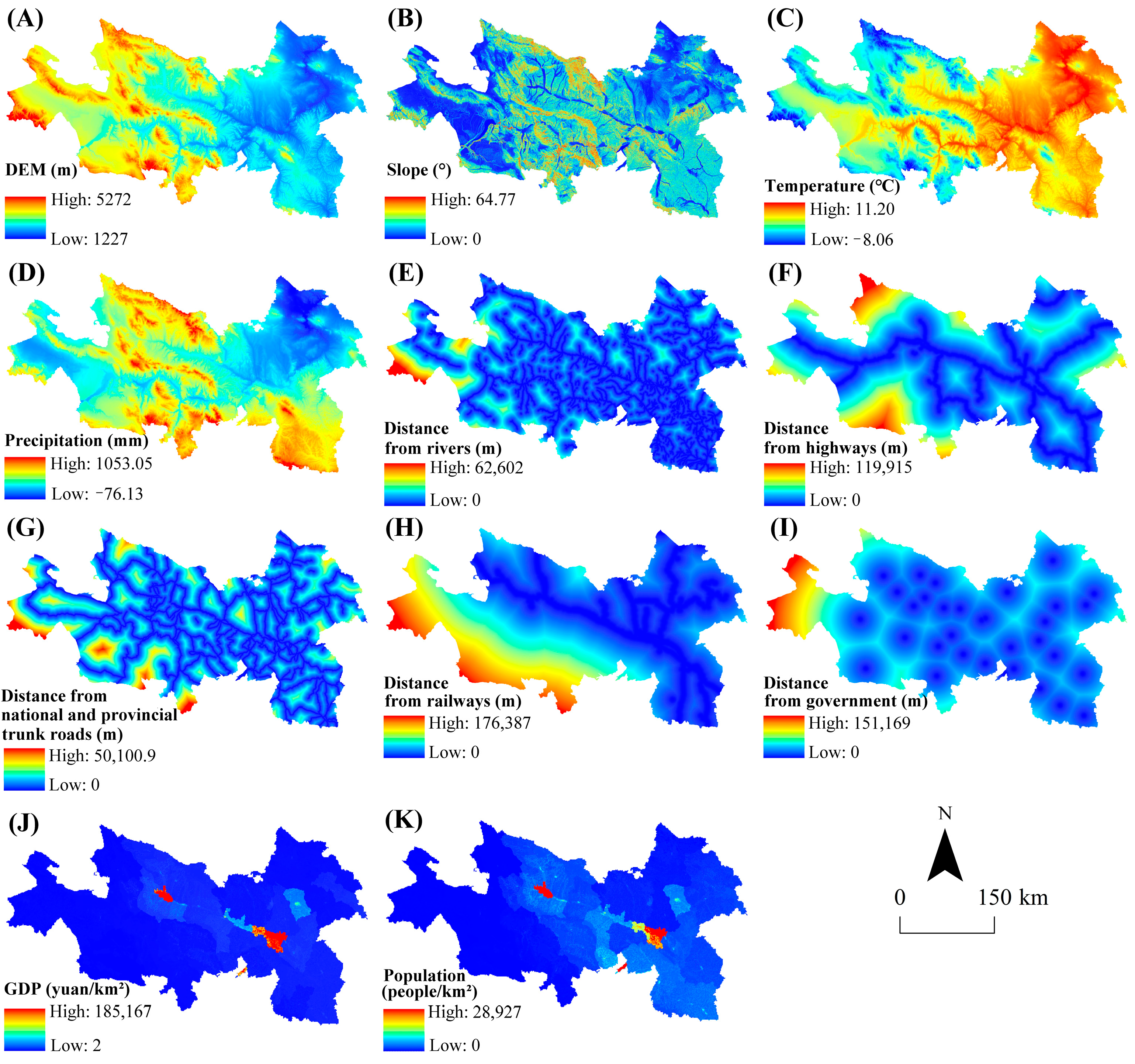
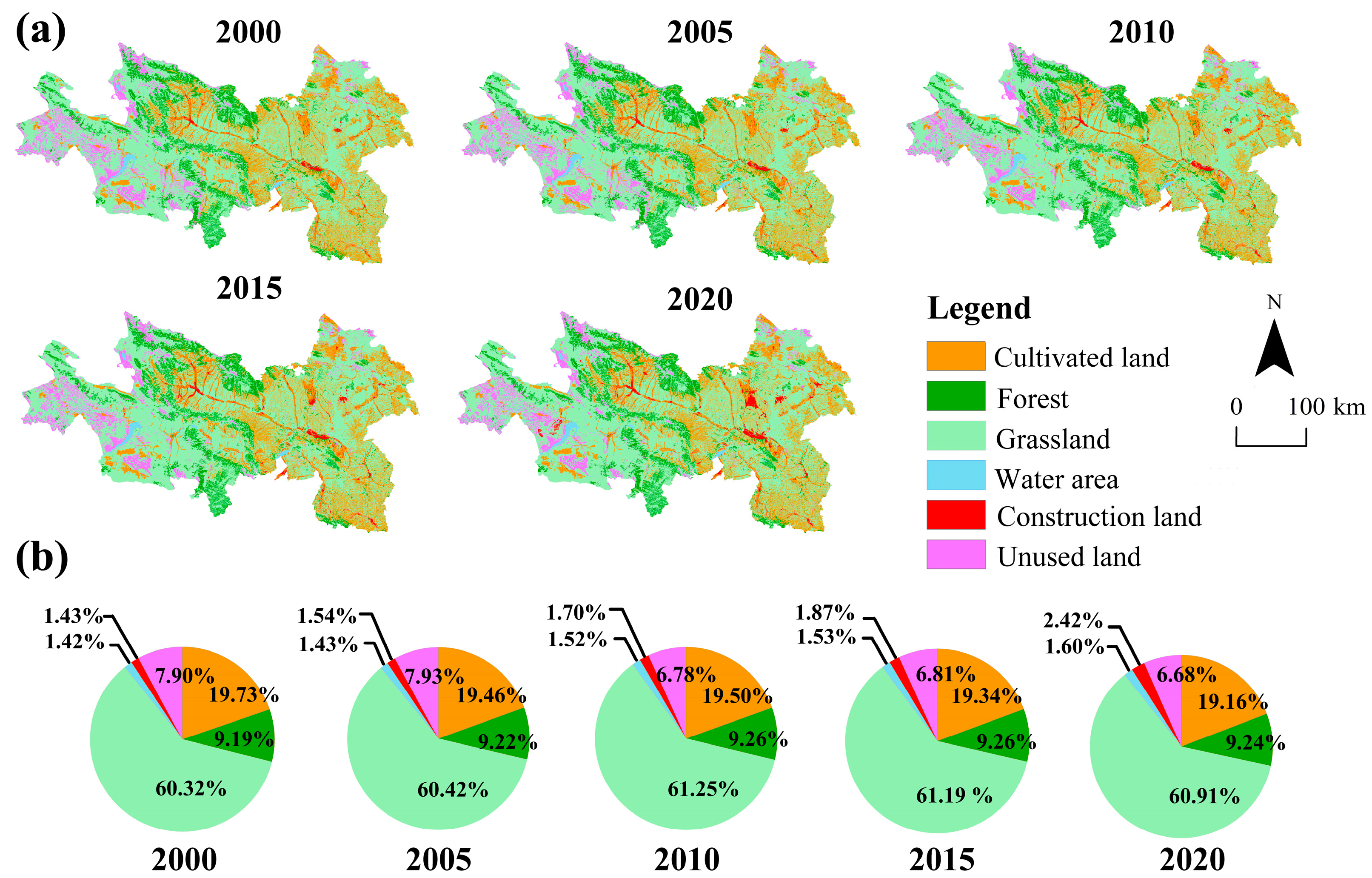
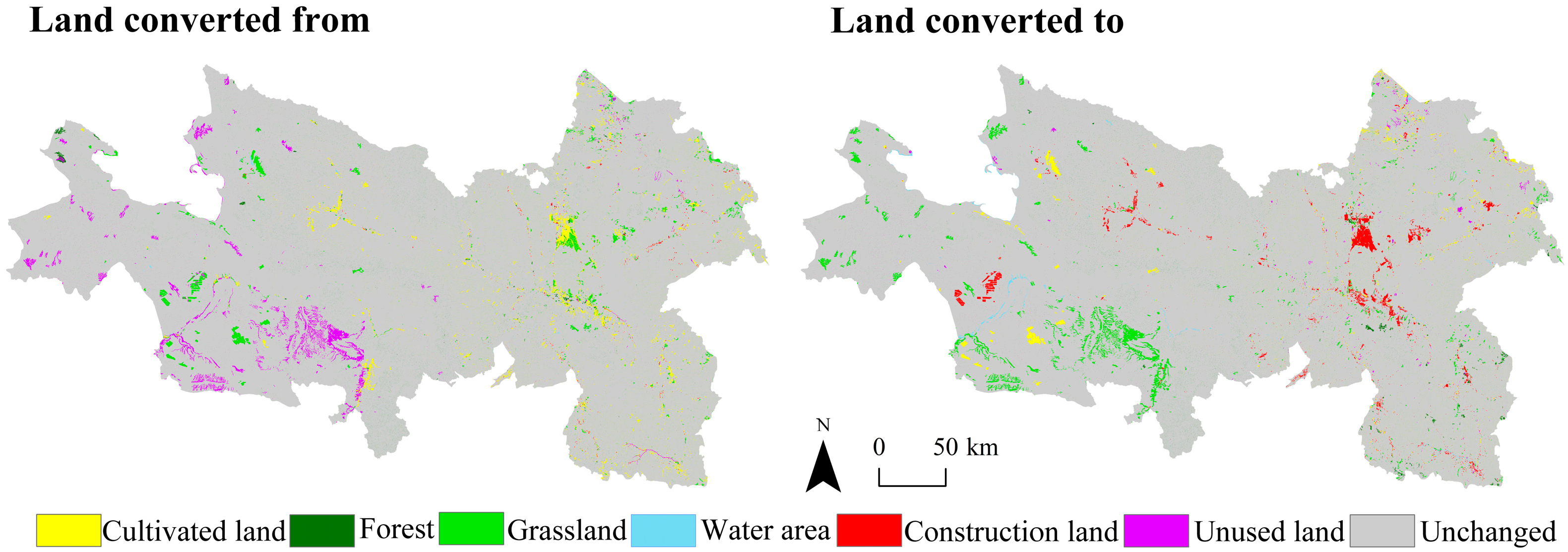

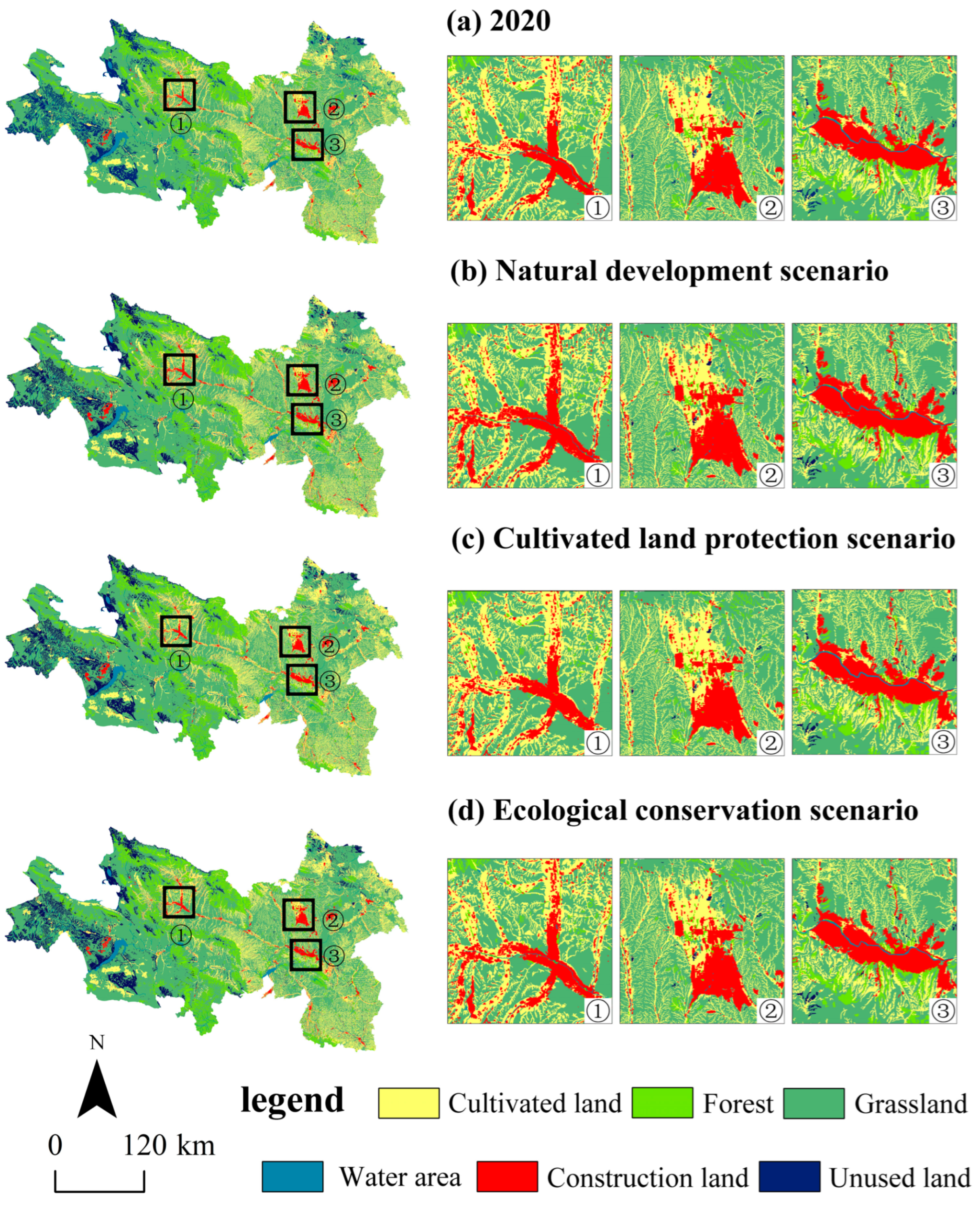
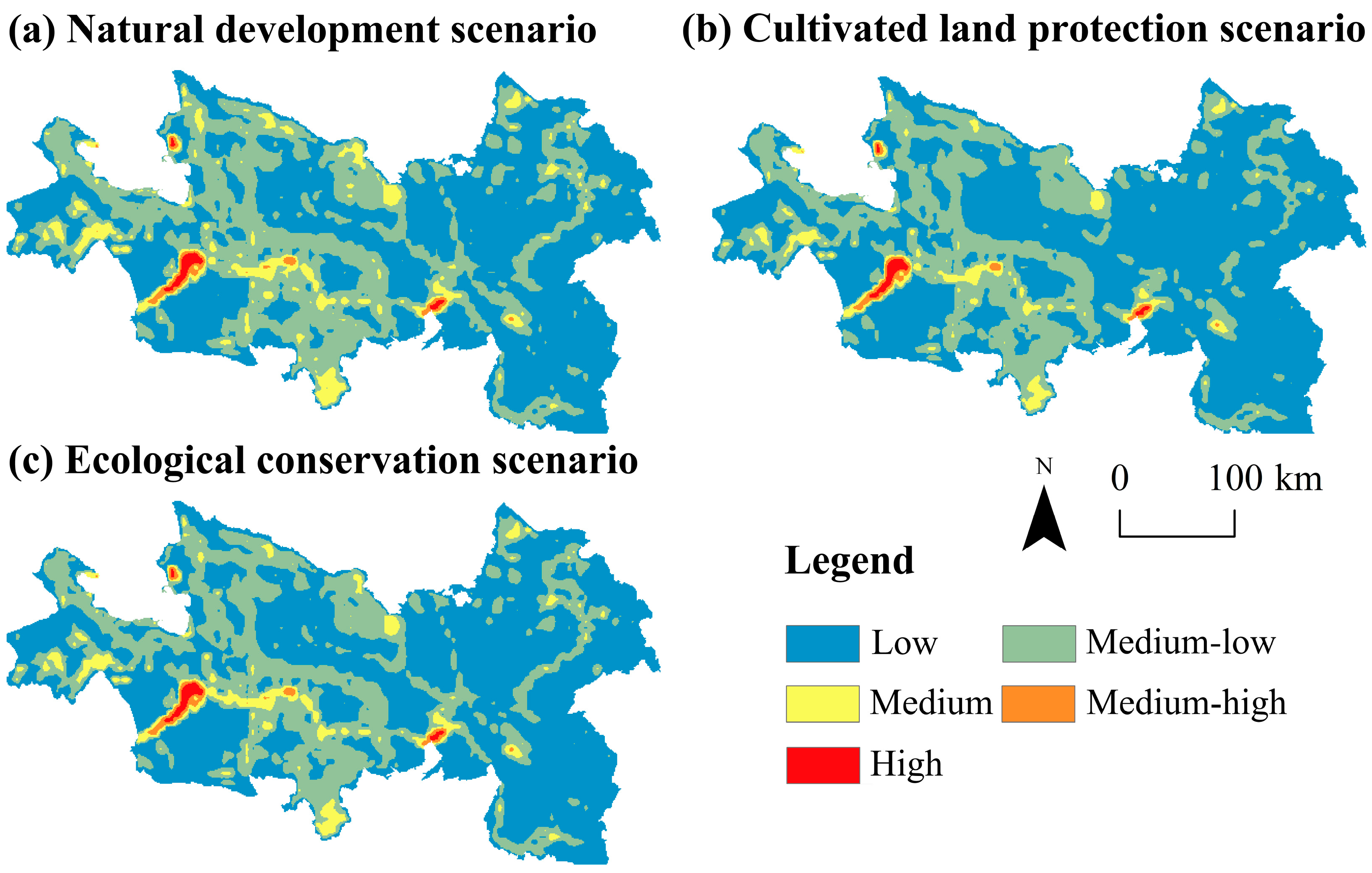
| Category | Data | Spatial Resolution | Time | Data Sources |
|---|---|---|---|---|
| Natural condition dataset | Land use | 30 m | 2000–2020 | https://www.resdc.cn (accessed on 10 April 2025) |
| DEM | 2020 | https://www.earthdata.nasa.gov (accessed on 10 April 2025) | ||
| Slope | Obtained by DEM | |||
| Rivers | Vector data | 2021 | https://www.webmap.cn (accessed on 10 April 2025) | |
| Temperature | 1 km | 2020 | https://www.resdc.cn (accessed on 10 April 2025) | |
| Precipitation | ||||
| social and economic dataset | GDP | 2019 | ||
| Population | ||||
| Railroads | Vector data | 2021 | https://www.webmap.cn (accessed on 10 April 2025) | |
| Highway | ||||
| Primary roads | ||||
| Secondary roads | ||||
| Tertiary roads | ||||
| Seat of county government | ||||
| Constrained dataset | Ecological conservation area | 2018 | https://www.resdc.cn (accessed on 10 April 2025) |
| Primary Type | Secondary Type | CL | FL | GL | WA | UL |
|---|---|---|---|---|---|---|
| Supply services | FP | 2015.57 | 553.29 | 379.40 | 1897.01 | 11.86 |
| RMP | 948.50 | 1272.58 | 557.25 | 545.39 | 35.57 | |
| WRS | 47.43 | 656.05 | 308.26 | 19,657.75 | 23.71 | |
| Adjustment services | GR | 1588.74 | 4173.42 | 1956.29 | 1825.87 | 154.13 |
| CR | 853.65 | 12,488.64 | 5169.35 | 5430.19 | 118.56 | |
| EP | 237.13 | 3714.97 | 1707.31 | 13,160.49 | 486.11 | |
| HR | 640.24 | 9034.50 | 3782.16 | 242,817.02 | 284.55 | |
| Support services | SM | 2442.40 | 5082.40 | 2383.12 | 2205.27 | 177.84 |
| MNC | 284.55 | 387.31 | 189.70 | 165.99 | 11.86 | |
| BD | 308.26 | 4631.86 | 2169.70 | 6046.71 | 165.99 | |
| Cultural services | AL | 142.28 | 2031.38 | 960.36 | 4481.68 | 71.14 |
| Total | 9508.75 | 44,026.39 | 19,562.90 | 298,233.37 | 1541.32 |
| Land Use Type | CL | FL | GL | WA | CSL | UL |
|---|---|---|---|---|---|---|
| −5066.55 | −272.25 | −456.93 | 227.52 | 5563.35 | 4.86 | |
| Neighborhood weight | 0.00 | 0.45 | 0.43 | 0.50 | 1.00 | 0.48 |
| 2020–2030 | NDS | CLPS | ECS | |||||||||||||||||
|---|---|---|---|---|---|---|---|---|---|---|---|---|---|---|---|---|---|---|---|---|
| a | b | c | d | e | f | a | b | c | d | e | f | a | b | c | d | e | f | |||
| a | 1 | 1 | 1 | 1 | 1 | 1 | 1 | 0 | 0 | 0 | 0 | 0 | 1 | 1 | 1 | 1 | 1 | 1 | ||
| b | 1 | 1 | 1 | 1 | 1 | 1 | 1 | 1 | 1 | 0 | 1 | 1 | 0 | 1 | 0 | 0 | 0 | 0 | ||
| c | 1 | 1 | 1 | 1 | 1 | 1 | 1 | 1 | 1 | 1 | 1 | 1 | 0 | 1 | 1 | 1 | 0 | 0 | ||
| d | 1 | 1 | 1 | 1 | 1 | 1 | 1 | 1 | 0 | 1 | 1 | 1 | 0 | 0 | 0 | 1 | 0 | 0 | ||
| e | 0 | 0 | 0 | 0 | 1 | 0 | 0 | 0 | 0 | 0 | 1 | 0 | 0 | 0 | 0 | 0 | 1 | 0 | ||
| f | 1 | 1 | 1 | 1 | 1 | 1 | 1 | 1 | 1 | 1 | 1 | 1 | 1 | 1 | 1 | 1 | 1 | 1 | ||
| 2020 | |||||||
|---|---|---|---|---|---|---|---|
| CL | FL | GL | WA | CSL | UL | ||
| 2000 | CL | 17,489.18 | 83.33 | 728.95 | 57.61 | 634.16 | 72.44 |
| FL | 26.77 | 8601.04 | 210.13 | 5.05 | 37.57 | 5.25 | |
| GL | 833.38 | 234.99 | 56,645.10 | 63.07 | 379.43 | 147.97 | |
| WA | 22.70 | 2.51 | 17.90 | 1306.08 | 16.03 | 6.13 | |
| CSL | 108.81 | 3.51 | 21.60 | 2.82 | 1247.45 | 0.55 | |
| UL | 32.30 | 7.83 | 1245.40 | 107.89 | 21.88 | 6219.73 | |
| Land Use Type | CL | FL | GL | WA | UL | Total | |
|---|---|---|---|---|---|---|---|
| 2000 | ESV | 181.31 | 391.26 | 1140.70 | 409.39 | 11.77 | 2134.44 |
| Proportion/% | 8.49% | 18.33% | 53.44% | 19.18% | 0.55% | 100.00% | |
| 2005 | ESV | 178.80 | 392.34 | 1142.43 | 412.90 | 11.81 | 2138.28 |
| Proportion/% | 8.36% | 18.35% | 53.43% | 19.31% | 0.55% | 100.00% | |
| 2010 | ESV | 179.20 | 394.26 | 1158.21 | 437.24 | 10.09 | 2179.00 |
| Proportion/% | 8.22% | 18.09% | 53.15% | 20.07% | 0.46% | 100.00% | |
| 2015 | ESV | 177.71 | 394.10 | 1156.88 | 440.79 | 10.15 | 2179.63 |
| Proportion/% | 8.15% | 18.08% | 53.08% | 20.22% | 0.47% | 100.00% | |
| 2020 | ESV | 176.05 | 393.34 | 1151.76 | 460.37 | 9.95 | 2191.47 |
| Proportion/% | 8.03% | 17.95% | 52.56% | 21.01% | 0.45% | 100.00% | |
| ESV changes from 2000 to 2020 | −5.26 | 2.09 | 11.06 | 50.97 | −1.82 | 57.04 | |
| ESV rate of change from 2000 to 2020 | −2.90% | 0.53% | 0.97% | 12.45% | −15.50% | 2.67% | |
| Ecosystem Service Functions | 2000 | 2005 | 2010 | 2015 | 2020 | |
|---|---|---|---|---|---|---|
| Supply services | FP | 68.17 | 67.70 | 68.26 | 67.94 | 67.60 |
| Proportion/% | 3.19% | 3.17% | 3.13% | 3.12% | 3.08% | |
| RMP | 62.91 | 62.75 | 63.30 | 63.11 | 62.81 | |
| Proportion/% | 2.95% | 2.93% | 2.90% | 2.90% | 2.87% | |
| WRS | 51.88 | 52.14 | 53.99 | 54.20 | 55.39 | |
| Proportion/% | 2.43% | 2.44% | 2.48% | 2.49% | 2.53% | |
| Adjustment services | GR | 185.14 | 185.02 | 186.82 | 186.45 | 185.69 |
| Proportion/% | 8.67% | 8.65% | 8.57% | 8.55% | 8.47% | |
| CR | 437.04 | 437.65 | 442.71 | 442.25 | 440.87 | |
| Proportion/% | 20.48% | 20.47% | 20.32% | 20.29% | 20.12% | |
| EP | 158.87 | 159.21 | 161.29 | 161.30 | 161.55 | |
| Proportion/% | 7.44% | 7.45% | 7.40% | 7.40% | 7.37% | |
| HR | 648.53 | 651.78 | 674.75 | 677.26 | 691.90 | |
| Proportion/% | 30.38% | 30.48% | 30.97% | 31.07% | 31.57% | |
| Support services | SM | 235.08 | 234.80 | 237.03 | 236.50 | 235.49 |
| Proportion/% | 11.01% | 10.98% | 10.88% | 10.85% | 10.75% | |
| MNC | 20.25 | 20.20 | 20.38 | 20.33 | 20.23 | |
| Proportion/% | 0.95% | 0.94% | 0.94% | 0.93% | 0.92% | |
| BD | 183.12 | 183.42 | 185.70 | 185.56 | 185.24 | |
| Proportion/% | 8.58% | 8.58% | 8.52% | 8.51% | 8.45% | |
| Cultural services | AL | 83.46 | 83.61 | 84.77 | 84.73 | 84.70 |
| Proportion/% | 3.91% | 3.91% | 3.89% | 3.89% | 3.87% | |
| ESV and Proportion | CL | FL | GL | WA | UL | Total | |
|---|---|---|---|---|---|---|---|
| 2020 | ESV | 176.05 | 393.34 | 1151.76 | 460.37 | 9.95 | 2191.47 |
| Proportion/% | 8.03% | 17.95% | 52.56% | 21.01% | 0.45% | 100.00% | |
| NDS scenario | ESV | 173.94 | 392.57 | 1145.20 | 462.37 | 9.81 | 2183.89 |
| Proportion/% | 7.96% | 17.98% | 52.44% | 21.17% | 0.45% | 100.00% | |
| CLPS scenario | ESV | 179.31 | 392.57 | 1145.20 | 421.56 | 9.81 | 2148.46 |
| Proportion/% | 8.35% | 18.27% | 53.30% | 19.62% | 0.46% | 100.00% | |
| ECS scenario | ESV | 173.21 | 393.43 | 1152.36 | 482.25 | 9.81 | 2211.06 |
| Proportion/% | 7.83% | 17.79% | 52.12% | 21.81% | 0.44% | 100.00% |
| Ecosystem Service Functions | NDS | CLPS | ECS | |
|---|---|---|---|---|
| The Primary Type | The Secondary Type | |||
| Supply services | FP | 67.03 | 67.91 | 67.15 |
| Volume of growth | −0.57 | 0.31 | −0.45 | |
| Growth rate (%) | −0.85 | 0.45 | −0.67 | |
| RMP | 62.39 | 62.85 | 62.58 | |
| Volume of growth | −0.42 | 0.04 | −0.23 | |
| Growth rate (%) | −0.67 | 0.07 | −0.36 | |
| WRS | 55.39 | 52.73 | 56.82 | |
| Volume of growth | 0.00 | −2.66 | 1.44 | |
| Growth rate (%) | 0.01 | −4.80 | 2.59 | |
| account | 184.81 | 183.49 | 186.56 | |
| Volume of growth | −0.99 | −2.31 | 0.76 | |
| Growth rate (%) | −0.53 | −1.24 | 0.41 | |
| Adjustment services | GR | 184.61 | 185.25 | 185.40 |
| Volume of growth | −1.08 | −0.44 | −0.29 | |
| Growth rate (%) | −0.58 | −0.24 | −0.15 | |
| CR | 438.76 | 438.50 | 441.19 | |
| Volume of growth | −2.12 | −2.38 | 0.32 | |
| Growth rate (%) | −0.48 | −0.54 | 0.07 | |
| EP | 160.90 | 159.24 | 162.46 | |
| Volume of growth | −0.65 | −2.31 | 0.91 | |
| Growth rate (%) | −0.40 | −1.43 | 0.56 | |
| HR | 691.94 | 659.08 | 709.64 | |
| Volume of growth | 0.03 | −32.83 | 17.73 | |
| Growth rate (%) | 0.01 | −4.74 | 2.56 | |
| account | 1476.21 | 1442.07 | 1498.69 | |
| Volume of growth | −3.81 | −37.95 | 18.67 | |
| Growth rate (%) | −0.26 | −2.56 | 1.26 | |
| Support services | SM | 234.05 | 235.13 | 234.98 |
| Volume of growth | −1.43 | −0.35 | −0.50 | |
| Growth rate (%) | −0.61 | −0.15 | −0.21 | |
| MNC | 20.10 | 20.23 | 20.16 | |
| Volume of growth | −0.13 | 0.00 | −0.07 | |
| Growth rate (%) | −0.66 | 0.02 | −0.33 | |
| BD | 184.38 | 183.73 | 185.65 | |
| Volume of growth | −0.85 | −1.51 | 0.41 | |
| Growth rate (%) | −0.46 | −0.81 | 0.22 | |
| account | 438.53 | 439.10 | 440.80 | |
| Volume of growth | −2.421 | −1.86 | −0.16 | |
| Growth rate (%) | −0.55 | −0.42 | −0.04 | |
| Cultural services | AL | 84.34 | 83.80 | 85.01 |
| Volume of growth | −0.37 | −0.90 | 0.31 | |
| Growth rate (%) | −0.43 | −1.06 | 0.37 | |
| Total | 2183.89 | 2148.46 | 2211.06 | |
| Volume of growth | −7.58 | −43.02 | 19.59 | |
| Growth rate (%) | −0.35 | −1.96 | 0.89 | |
Disclaimer/Publisher’s Note: The statements, opinions and data contained in all publications are solely those of the individual author(s) and contributor(s) and not of MDPI and/or the editor(s). MDPI and/or the editor(s) disclaim responsibility for any injury to people or property resulting from any ideas, methods, instructions or products referred to in the content. |
© 2025 by the authors. Licensee MDPI, Basel, Switzerland. This article is an open access article distributed under the terms and conditions of the Creative Commons Attribution (CC BY) license (https://creativecommons.org/licenses/by/4.0/).
Share and Cite
Bai, J.; Jia, Z.; Sun, Y.; Zheng, C.; Wen, M. Multi-Scenario Simulation of Land Use Change Along with Ecosystem Service Value for the Lanzhou–Xining Urban Agglomeration. Land 2025, 14, 860. https://doi.org/10.3390/land14040860
Bai J, Jia Z, Sun Y, Zheng C, Wen M. Multi-Scenario Simulation of Land Use Change Along with Ecosystem Service Value for the Lanzhou–Xining Urban Agglomeration. Land. 2025; 14(4):860. https://doi.org/10.3390/land14040860
Chicago/Turabian StyleBai, Jing, Zhuo Jia, Yufan Sun, Chengyi Zheng, and Mingxing Wen. 2025. "Multi-Scenario Simulation of Land Use Change Along with Ecosystem Service Value for the Lanzhou–Xining Urban Agglomeration" Land 14, no. 4: 860. https://doi.org/10.3390/land14040860
APA StyleBai, J., Jia, Z., Sun, Y., Zheng, C., & Wen, M. (2025). Multi-Scenario Simulation of Land Use Change Along with Ecosystem Service Value for the Lanzhou–Xining Urban Agglomeration. Land, 14(4), 860. https://doi.org/10.3390/land14040860






